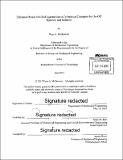| dc.contributor.advisor | Pedro M. Reis. | en_US |
| dc.contributor.author | McDermott, Ryan A | en_US |
| dc.contributor.other | Massachusetts Institute of Technology. Department of Mechanical Engineering. | en_US |
| dc.date.accessioned | 2016-01-15T21:10:42Z | |
| dc.date.available | 2016-01-15T21:10:42Z | |
| dc.date.copyright | 2015 | en_US |
| dc.date.issued | 2015 | en_US |
| dc.identifier.uri | http://hdl.handle.net/1721.1/100883 | |
| dc.description | Thesis: S.B., Massachusetts Institute of Technology, Department of Mechanical Engineering, 2015. | en_US |
| dc.description | Cataloged from PDF version of thesis. | en_US |
| dc.description | Includes bibliographical references (pages 42-43). | en_US |
| dc.description.abstract | Using a desktop scale analog for the injection of a thin rod into a horizontal pipe to service wellbores in the oil industry, we perform an experimental investigation of the effect of rotating a thin rod as it undergoes on-off injection into a cylindrical constraint. When a thin rod is injected into a cylindrical constraint, the force required to continue injection increases over time, thus causing stresses to build inside the rod. These stresses eventually lead to buckling configurations, which can be described as sinusoidal and helical. If the stress in the rod continues to increase while in a helical configuration, the rod will reach a "lock-up" state, where the rod can no longer progress through the cylinder. To perform experiments, a custom manufactured elastic rod is injected into a borosilicate tube. A rotating apparatus was designed and constructed to rotate the rod at the injection site, allowing rotation to propagate through the entire rod, thus causing the length until lock-up to increase. This enhanced reach is directly proportional to rotation speed and radius of the rod, and inversely proportional to injection speed. Initial experiments examined the effect of rotation speed on the release time, which is the time required for a rod in a helical configuration to release into a straight configuration while experiencing rotation. The relationship between rotation speed and release time is exponential, with slower rotation speeds having a large release time and faster rotation speeds reaching an asymptote. The relationship between helical initiation length and release time is linear, but release times vary significantly for the same helical initiation lengths. On-off injection consisted of using a stepper motor to inject the rod with a square wave function that had a 50% duty cycle. The lock up length and helical initiation length were examined for different square wave periods. On-off injection with rotation can enhance the rod's reach by at least 175% as compared to the only rotation condition. This is evidence that on-off injection can significantly enhance the reach of rods injected into cylindrical constraints. | en_US |
| dc.description.statementofresponsibility | by Ryan A. McDermott. | en_US |
| dc.format.extent | 43 pages | en_US |
| dc.language.iso | eng | en_US |
| dc.publisher | Massachusetts Institute of Technology | en_US |
| dc.rights | M.I.T. theses are protected by copyright. They may be viewed from this source for any purpose, but reproduction or distribution in any format is prohibited without written permission. See provided URL for inquiries about permission. | en_US |
| dc.rights.uri | http://dspace.mit.edu/handle/1721.1/7582 | en_US |
| dc.subject | Mechanical Engineering. | en_US |
| dc.title | Enhanced reach of a rod injected into a cylindrical constraint by on-off injection and rotation | en_US |
| dc.type | Thesis | en_US |
| dc.description.degree | S.B. | en_US |
| dc.contributor.department | Massachusetts Institute of Technology. Department of Mechanical Engineering | |
| dc.identifier.oclc | 933609874 | en_US |
